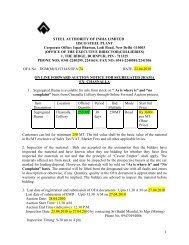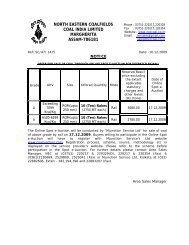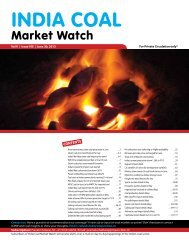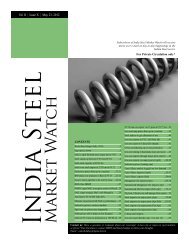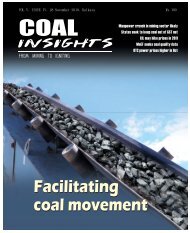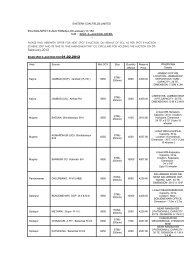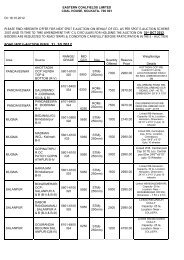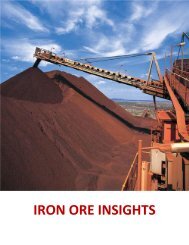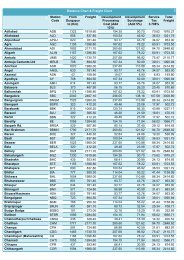India's largest coal handling agency - Mjunction
India's largest coal handling agency - Mjunction
India's largest coal handling agency - Mjunction
Create successful ePaper yourself
Turn your PDF publications into a flip-book with our unique Google optimized e-Paper software.
Cover Story<br />
INDUSTRIAL GROWTH INDICATORS - Sectoral<br />
Growth Rates based on IIP<br />
(Growth Rate in percent)<br />
Item<br />
Weight<br />
(%)<br />
2007-08 2008-09<br />
Apr-Nov<br />
08-09<br />
Apr-Nov<br />
09-10<br />
Overall 100 8.5 2.8 4.1 7.6<br />
Mining and Quarrying 10.5 5.1 2.6 3.4 8.3<br />
Manufacturing 79.4 9 2.8 4.2 7.7<br />
Electricity 10.2 6.4 2.8 2.8 6.1<br />
Source: Ministry of Heavy Industries and Public Enterprises &<br />
Insights Research<br />
Sales of equipments in India in units sold<br />
Year International players in India Indian Players<br />
2008-09 4200 500<br />
2009-10 5500 600<br />
2010-11 (Upto Sept) 2700 200<br />
Source: Komatsu & Insights Research<br />
of 8.3 percent during the same period compared to 3.4 percent<br />
registered in the corresponding period of last year. Keeping<br />
this in mind, Coal Insights took a close look at the equipment<br />
manufacturing sector, which is poised to play a crucial role in<br />
the mining growth that is just waiting to happen.<br />
“The equipment industry is in good shape and there is<br />
huge demand for mining equipment. Moreover with massive<br />
expansion plans mapped by SAIL and CIL, mining activities<br />
would considerably rise, the demand for mechanisation and<br />
highly productive, safe, efficient and cost effective machinery<br />
will increase, and thus the growth in demand is inevitable,”<br />
said an industry expert.<br />
The new mining policy of the government of India is also<br />
expected to give a further boost to the mining sector. As per<br />
industry experts, the mining sector now accounts for 2.8<br />
percent of the GDP, and the figure is slated to go up.<br />
“Currently, the market size of mining equipment in the<br />
country is estimated to be over Euro 1 billion. Being a highly<br />
competitive industry, it comprises public as well as private<br />
sector companies including joint ventures and closely held<br />
companies,” said Nath.<br />
However, the Indian local equipment market is still at a<br />
nascent stage, except for some companies like who supply to<br />
the Indian requirements, rest is imported or purchased from<br />
the foreign companies with units in India,” said an official of<br />
Komatsu, an international equipment manufacturer.<br />
Due to the present demand-supply gap, a lot of the current<br />
demand is met by imports. “Around 70 to 80 percent of the<br />
domestic requirement is catered by the domestic production<br />
which is inclusive of the international players who have set<br />
up units in India, while the rest is imported,” a market expert<br />
said. India imports largely from Russia, Germany, China<br />
and also North America. In addition to this, there are many<br />
international companies in the Indian market who import on<br />
behalf of the miners. Some of these companies do not have<br />
manufacturing base but have technology. Thus the designing<br />
is done by them as per market conditions and then it is<br />
manufactured in their base units which is then imported to<br />
India.<br />
“India imports around Euro 600 to 650 million of mining<br />
equipment,” noted Nath. The rationale behind increasing<br />
imports is the perceptible shift in trend towards using larger<br />
size, cost effective and technologically upgraded equipment to<br />
meet the exponentially growing demand for minerals.<br />
“With increasing activity, Indian miners are now looking<br />
for more efficient and technologically sound machines for good<br />
production. Thus, despite the fact that the machineries made<br />
by the foreign companies are expensive, they are gradually<br />
getting accepted in the Indian market. The advantage is that<br />
although there is a high initial investment, the long term<br />
maintenance cost is much lower. Thus, after some resistance<br />
amidst the Indian buyers, it is slowly picking up now,” the<br />
official of Komatsu informed.<br />
In addition to this, most of these products are not<br />
manufactured in India or Indian companies and thus<br />
have to be imported, Coal Insights gathered. Around 80 to<br />
85 percent of the equipment for underground mining are<br />
imported while around 20 to 25 percent are imported for<br />
opencast mining.<br />
“Basically the earlier methods were not efficient, and<br />
machines used to break down. Now with increasing<br />
production, more reliable equipment is required, which will<br />
help in better production,” said an industry expert.<br />
Vis-à-vis the global market, India fares well in terms of price<br />
and quality. However, Indian equipment manufacturers lag<br />
behind their international counterparts in terms of technology,<br />
market experts feel. “Indian equipment is cheaper but there<br />
are limitations in capacity. High capacity equipment is not<br />
yet available in India,” pointed out Nath. “Indian products<br />
are competitive in terms of prices and also in terms of quality<br />
but technological upgradation is required,” said an official of<br />
HEC, one of the leading domestic equipment supplier and<br />
manufacturer.<br />
Thus, the Indian equipment manufacturers are upgrading<br />
themselves both in terms of quality as well as capacity in<br />
order to make themselves globally competitive. “India is<br />
campaigning abroad to take up international mining projects,”<br />
said an official of BEML, the public sector equipment<br />
manufacturing biggie.<br />
Indian equipment has found markets in the Middle East<br />
and Africa, where cost-competitiveness is a bigger factor than<br />
technology. It is also supplying some spares to Europe and<br />
the US.<br />
The sourcing<br />
Indian mine owners generally acquire the equipment by two<br />
routes. They either purchase it or take it on rent or lease. It will<br />
COAL INSIGHTS 8 October 2010



